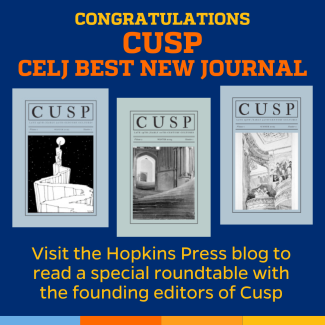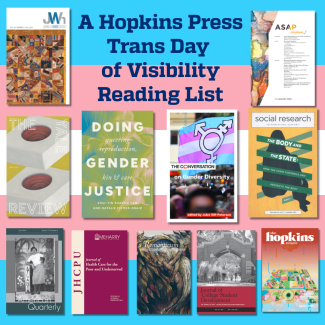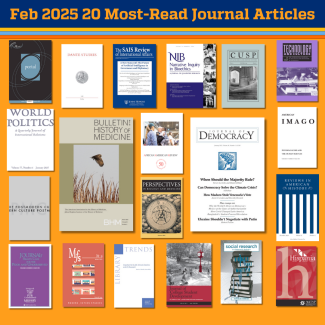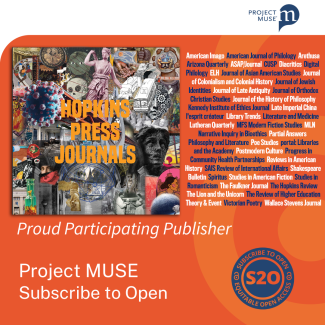
Editors' Roundtable: Cusp Crowned 2024 CELJ Best New Journal

Cusp: Late 19th-/Early 20th-Century Cultures was awarded the Best New Journal award by the Council of Editors of Learned Journals in a ceremony at the Modern Language Association conference in January.
With this award, Cusp joins the ranks of five other CELJ Best New Journal winners published by Hopkins Press: ASAP/Journal (2017), Partial Answers (2004), Book History (1999), South Central Review (1984), and Rhetorica (1983)—not to mention the 1995 runner-up title for Modernism/modernity, and the honorable mention for Journal of Women's History in 1990.
To celebrate, we gathered the founding editors—Kate Hext, Kristin Mahoney, and Alex Murray—together with Hopkins Press Journals publisher Bill Breichner in a roundtable Q&A to talk about the founding of Cusp, and what plans they have for the future.
A new edition of Cusp, the first issue of the journal's second volume, has just been released. Read and subscribe here.
What sparked the idea of Cusp?
Kate Hext: In November 2019, Regenia Gagnier happened to mention en route to dinner with me and Kristin in Exeter that the journal English Literature in Transition, 1880-1920 would soon cease publication. We were shocked this journal was essential to the field of fin-de-siecle studies—and we knew that somehow we had do something about it. I could hear Kristin’s mind working as we walked. Over the coming weeks, there was a fever of WhatsApping with Alex to work out what that "what" would be. It was certainly not our first idea to found a new journal but our best ideas seem to evolve over dinner.
Alex Murray: I’ve gone back and found the messages and emails in which we first started discussing the demise of ELT and what could be done. There is no evidence in that correspondence of a grand plan—we each suggested that the others would be great editors, but not ourselves! But it is clear from that correspondence that we wanted a space in which those who, like us, work across the cusp of the 19th/20th centuries would have a journal that would sustain conversations and communities. But we also wanted a new kind of journal, one that embraced a truly global view of the period, and that welcomed all approaches.
Kristin Mahoney: At the time ELT was folding, I was hearing from many people in the field, not only Kate and Alex, what a shame it would be to lose this space for people whose work operates across the turn of the century. And yes, as Alex mentions, it did seem like, in many of these conversations, the message was “someone needs to keep this going, but I would not like to be the one to do it.” I can’t even remember what got Kate, Alex, and I to change our minds. But it was Kate who initially reached out to Bill Breichner at Hopkins Press and mentioned the “possibility of a new journal that would offer transcultural and interdisciplinary content on 'the long turn-of-the-century.’” Bill said that the prospects for starting a new journal weren’t great, but he would be willing to meet with us at MLA in Seattle in 2020. I do remember Kate and I nervously drinking coffee together and reviewing our notes right before the meeting. However, once we got to the meeting, Bill seemed truly interested and so supportive. His enthusiasm was part of what made me start to see this as a real possibility.
Bill Breichner: I was in conversation with Robert Langenfeld, who was the editor and publisher of ELT, about acquiring the journal and naming a new editor, but he decided that ELT would retire with him. My disappointment turned to excitement after meeting with Kate and Kristin in Seattle and learning what the two of them and Alex were envisioning for the journal that became Cusp. We don’t start many new journals. Cusp is just one of nine that I’ve helped launch in my 22 years as head of the Hopkins Press Journals Division and I’ve always attached high expectations with these projects. Cusp just felt right from the start. I wasn’t joking when I told everyone that I expected the journal to be award-winning. Kate’s, Kristin’s, and Alex’s vision for the journal seemed to align quite well with the need that was created with the shutting down of ELT. It took a while to get up and running, but the first issue was very well-received at the 2023 MLA meeting in San Francisco and it became clear that Cusp could be special.
Was “founding a journal” an item on your list of professional goals?
KH: No.
AM: I had founded a philosophy journal in 2006, from which I stepped down in 2014. The one professional goal I took away from that experience was not to found another journal, but here we are….
KM: No! But I did appreciate the opportunity to get to work closely with Kate and Alex, who are ideal collaborators.
KH: I think we came to realize in our discussions that the as-then-unnamed journal would be part of the international academic community that we value and want very much to promote. So, in a way, that sold the idea.
What work goes into founding a journal?
AM: It requires a great many conversations and a lot of support from various people. Kate and I had published with Catherine Goldstead in Hopkins Press books and asked her for advice on how we might approach journals. From that we got in contact with Bill, who was wonderfully supportive. He then went away and consulted senior scholars in the field who were also very supportive. After a long process of proposals and negotiations we signed contracts. That was 18 months after we had started conversations amongst ourselves. There was then another two years of planning before 1.1 was published. And in the background we were having meeting upon meeting working out all the details of our vision. The most intense conversations were about design concept.
KH: Yes, we were very invested in the design and have rather definite ideas.
KM: Something I think we are still working on is getting word out about the journal. We are trying to be present at as many conferences as possible, but ideally I think we would be attending even more, talking to people in American studies, cinema studies, South Asian studies, or art history to an even greater extent. I think if we truly want this journal to be more interdisciplinary and transnational, it is going to require putting even more energy into publicizing our vision for the journal. I do feel like one-on-one conversations after panels or roundtables are really helping to communicate what we want this journal to be and what kind of work we would like to see, but I wish we could be in more places to get the word out more quickly.
What’s something you wish you’d known before starting the journal?
AM: How much time I would be spending on Zoom and WhatsApp! It’s actually been a lot of fun working together. I knew Kristin, Kate and I would work well together, but I didn’t know how entertaining our editorial meetings would be.
KH: Fortunately, we can sometimes have our editorial meetings over drinks before a conference, though mostly we’re dashing to a Zoom call in between seminars. On things we wished we’d known sooner: the journal’s title! We approached Bill with various stop-gaps that would have served the purpose but weren’t quite captivating enough. My husband thought of Cusp quite late in the day and it soon stuck.
Was it challenging to find content for the first issues, or were authors eager for this?
AM: For the first issue we largely solicited position pieces from our advisory board, which was straightforward. We then commissioned the wonderful Rob Harris to guest edit 1.2 and he brought in an amazing roster of scholars working on impressionism. So, it was relatively straightforward to get the first few issues together.
KM: We were so lucky in terms of the content we were able to get for those first couple issues. The members of our advisory board wrote beautiful position pieces that read together almost operate as a manifesto for what we are trying to do with the journal.
Was it challenging to assemble an advisory board?
AM: No! Pretty much everyone said yes, and enthusiastically.
KH: I think everyone said yes, didn’t they? The field of fin-de-siecle studies has been burgeoning over the past decade or more, and I think there was recognition from senior scholars in the field that a journal is essential.
Has your vision for Cusp changed/grown/expanded since the launch? How so?
KH: The concept of the academic journal has expanded and become much less rigid in recent years. We admire, for example, Modernism/modernity’s PrintPlus platform, and see various opportunities to publish and circulate world-leading academic research in new ways. With Cusp —and this is a related point to some extent—we aim to model the kind of academic journal that we would like to read and be published in—friendly and lively while maintaining the highest academic standards. Like a lot of young academics, one of my first experiences of submitting an article to a big journal was waiting for two years to receive a high-handed rejection. That will never happen in Cusp. (And actually my essay wasn’t half bad.) With the nuts and bolts of design, publishing schedules, and the day-to-day in place, I increasingly think about Cusp’s ethos.
KM: We have also been talking quite a bit about soliciting different kinds of content–clusters, reviews of exhibits or performances, notes, interviews. I like the idea of Cusp not just being wholly traditional in terms of the forms we publish. And I do think people appreciate these shorter forms as a way to keep up with things happening in the field.
I imagine the “Best New Journal” title brings a little boost of energy with it. Is this going to change your approach going forward?
AM: It is certainly a nice accolade so early on in the journal’s life. It isn’t going to change our approach at all. We are still in the very early stages of developing the journal’s identity and reputation. That will take 5-10 years. At that point I could imagine passing over the reins to a new set of editors. I think it’s important that the journal’s identity grows and shifts with the field, and that requires constant renewal.
KM: The judges’ comments really affirmed our sense of the journal’s mission. They expressed admiration for our attentiveness to this “fecund historical hinge era, when the fragile remnants of early modernity and its ideals and institutions (science and reason triumphant) yield to the transformative pressures and forces of our own late modernity.” It was wonderful to hear them mention how vital and interesting this period is. I am hoping the prize might get more eyes on the journal and the fantastic work we have been able to publish so far. And I hope it helps to get the word out to more potential authors as well.
What do you have in store for readers in upcoming issues?
AM: 2.2 is going to feature a cluster of essays, edited by the brilliant Robert Volpicelli, on disability studies at the cusp. It brings together some wonderful scholars and is very timely in the issues it raises. There’s also essays on contemporary controversies over late-Victorian art; cosmopolitanism in the circle around Alice and Wilfrid Meynell; and a study of the Decadent novels of Norwegian writer Amalie Skram. We will also be publishing reviews on recent art exhibitions in New York and Oxford, and the one-woman Dorian Gray in London starring Sarah Snook. We are also hatching plans for a future special issue on translation and a cluster on cosmopolitanism.
KH: Our reviews section is new in Volume 2 and, due to demand, we have retitled this section as "Notes and Reviews," with space for short pieces that would be of interest to readers. I am very glad that we can offer this short form for essay submissions and hope it will be generative in a number of ways—new collaborations, say, or simply as an incentive to work on a fledgling idea that is not (yet) a longer article.
KM: I would really like to see us doing more clusters like the one Robert Volpicelli put together for us on disability studies. I love these snapshots of how a diverse group of scholars are thinking about a concept or method, and I want us to continue soliciting things like that for the journal.


